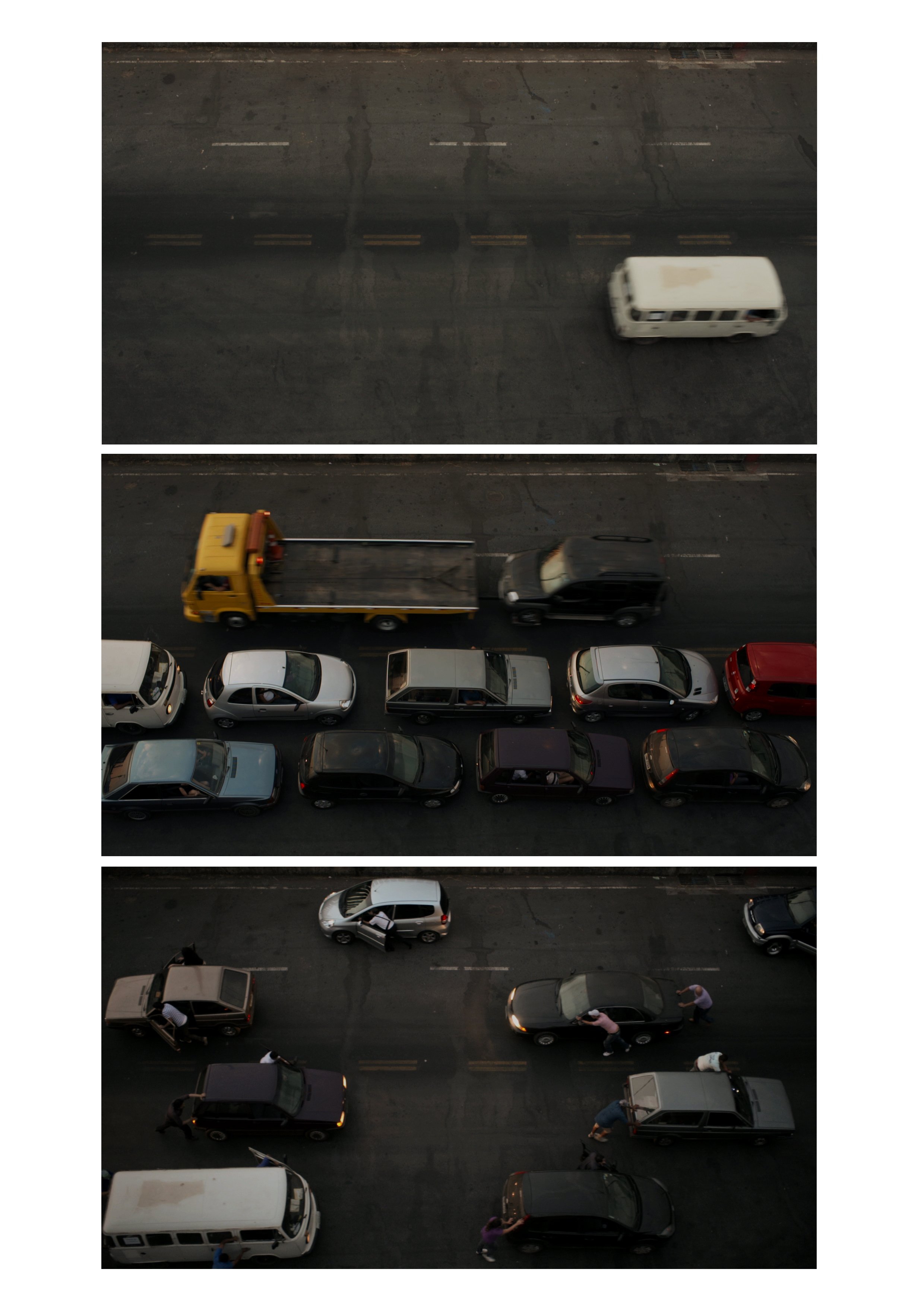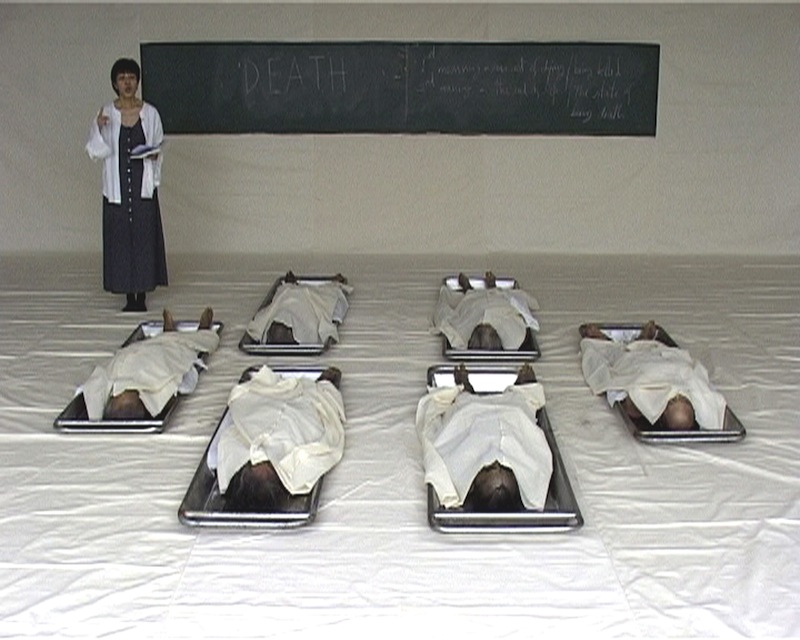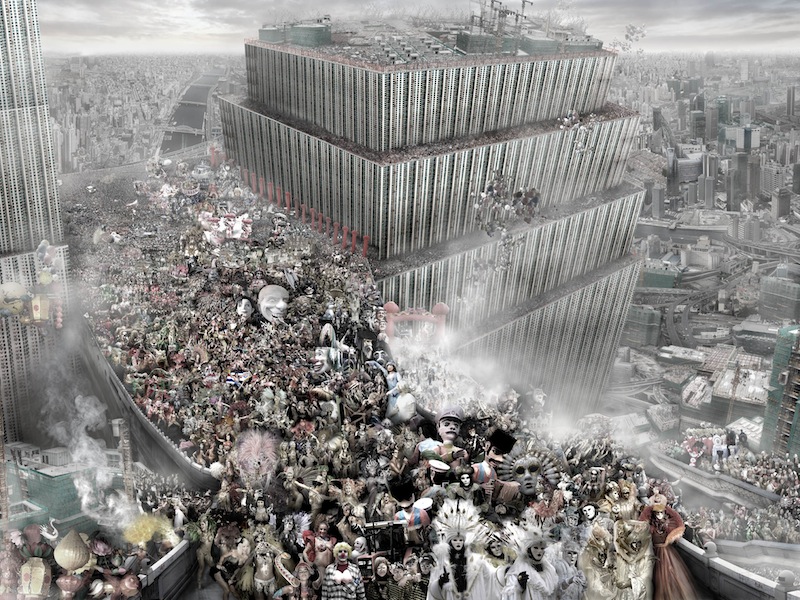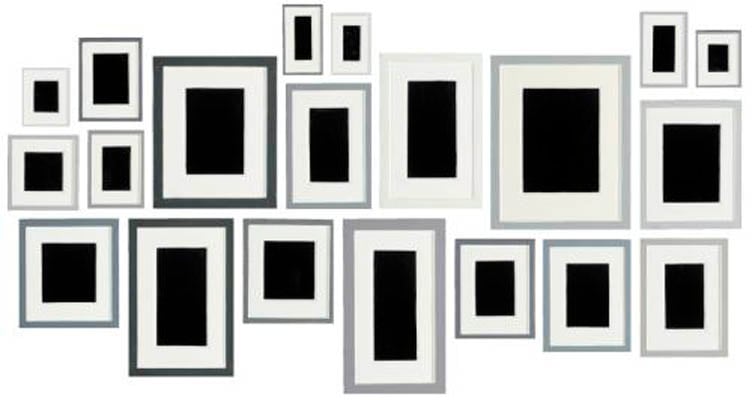
© » KADIST
Chen Chieh-Jen
Empire’s Borders II – Passage and Empire’s Borders II – Workers are from the three-channel film installation Empire’s Borders II – Western Enterprise, Inc. (2010), which takes as its point of departure the political context of the 1950s and the Cold War, when American interests in Taiwan overlapped with the Chinese civil war. Cooperating with the Chinese Kuomintang, the American CIA established something called Western Enterprises, an agency whose main tasks included training an anti-Communist National Salvation Army (NSA) for a surprise attack on Communists in mainland China and establishing Taiwan as a base for anti-Communist operations in Southeast Asia. Narrated from the point of the view of the artist’s father, once a member of the NSA, the project interweaves personal experience with historical events.

© » KADIST
Chen Shaoxiong
After engaging primarily with video and photography for more than a decade, Chen turned to painting to explore the issue of urban change and memories—both personal and collective. This “return to origin” reveals an interesting critical reflection on the interactive relation between outside change and internal reflection, and the possibility for more experimental approaches that revive “traditional media.” Chen’s series Collective Memories depicts some of the most important architectural works and urban sites in modern Chinese society, especially those related to the history of revolutions. Instead of reproducing the images himself, Chen invited the public to participate in their making by using their fingers to paint directly on the paper or canvas.

© » KADIST
Chen Chieh-Jen
Empire’s Borders II – Passage and Empire’s Borders II – Workers are from the three-channel film installation Empire’s Borders II – Western Enterprise, Inc. (2010), which takes as its point of departure the political context of the 1950s and the Cold War, when American interests in Taiwan overlapped with the Chinese civil war. Cooperating with the Chinese Kuomintang, the American CIA established something called Western Enterprises, an agency whose main tasks included training an anti-Communist National Salvation Army (NSA) for a surprise attack on Communists in mainland China and establishing Taiwan as a base for anti-Communist operations in Southeast Asia. Narrated from the point of the view of the artist’s father, once a member of the NSA, the project interweaves personal experience with historical events.

© » KADIST
Choi Jeong-Hwa
The application of bright colors and kitsch materials in Flower Tree manifests a playful comment on the influence of popular culture and urban lifestyle. And though his works share a similar sensibility to Claes Oldenburg’s oversized sculptures from everyday objects, Choi draws from his immediate surroundings and life experience. Public sculptures with a flower theme are often used to decorate the rapidly urbanized cities in Asia, which are constructed with concrete and steel materials.

© » KADIST
Oscar Munoz
In Ante la imagen (Before the Image, 2009) Muñoz continues to explore the power of a photograph to live up to the memory of a specific person. Since a photograph is fixed, it cannot encapsulate the spirit of someone who is gone. Muñoz etched onto the surface of a mirror an appropriated historical image, a daguerreotype from 1839.

© » KADIST
Francis Alÿs
Drawing & Print (Drawing & Print)
This series of small drawings is executed with varying materials—pen, ink, colored pencil, charcoal, and masking tape—on architect’s tracing paper. Alÿs often executes such sketches in preparation for his performances, videos, and larger two-dimensional bodies of work. As the first visual representations of his ideas, they capture his thinking processes at the raw conceptual stage and allow us to gain a deeper understanding of his larger works.

© » KADIST
Regina José Galindo
La Sombra (The Shadow) is a video of Regina Jose Galindo performing with a moving Leopard tank. The artist runs until exhaustion across a dirt field in what looks like a military site. Recorded for the camera, and projected on loop, the video performance was created for Documenta 14.

© » KADIST
Cinthia Marcelle
Cinthia Marcelle’s video work Automóvel (2012) re-edits the mundane rhythms of automotive traffic into a highly compelling and seemingly choreographed meditation on sequence, motion, and time. Shot from an aerial vantage, the camera tracks the daily commute on a small stretch of concrete highway. The camera films the traffic below in short five-second excerpts before blacking out; time begins to collapse as the video shifts between scene, and the hours compress into minutes as daylight quickly turns into night.

© » KADIST
Araya Rasdjarmrearnsook
The Class (2005) by Araya Rasdjarmrearnsook challenges the viewer’s personal sense of morality and tolerance by depicting a classroom from hell. In the video, a woman, dressed in black with a white over shirt, stands in front of a long blackboard. The classroom’s rear walls and floor are covered in taut white fabric, given the room the sinister appearance of a sanitarium or a crime scene.

© » KADIST
Regina José Galindo
In 2012, former Guatemalan President José Efran Ros Montt was charged with genocide and crimes against humanity; Regina José Galindo’s video Tierra is a chilling reimagining of the atrocities recounted during his trial. Tierra depicts the artist standing naked in a lush field that a bulldozer has broken up. The video references an incident in which innocent Guatemalans were brutally murdered and buried in a mass grave.

© » KADIST
Andrea Bowers
Bowers’ Radical Hospitality (2015) is a sculptural contradiction: its red and blue neon letters proclaim the words of the title, signaling openness and generosity, while the barbed wires that encircle the words give another message entirely. Meant to hang from the ceiling, Bowers’ neon is further weighed down by long wind chimes made of aluminum pipes and wooden wind catchers that drip unsteadily from their anchors. Poetic but frantic in its juxtapositions, Bowers’ work captures a certain paradoxical energy that echoes the current political climate—it is hopeful but hindered, cacophonous but well intentioned, uncertain but ominous.

© » KADIST
Félix González-Torres
Behind the simplicity and beauty of this untitled photograph of a brilliantly-colored flowerbed by Félix González-Torres are two remarkable stories of love, loss, and resilience. As with most of his works, the photograph is untitled followed by a parenthesis that provides some context clues. In this case, an inscription on the reverse of the photograph reads: For Laura (Alice B. Toklas + Gertrude Stein Flower Bed in Paris).

© » KADIST
Chen Shaoxiong
After engaging primarily with video and photography for more than a decade, Chen turned to painting to explore the issue of urban change and memories—both personal and collective. This “return to origin” reveals an interesting critical reflection on the interactive relation between outside change and internal reflection, and the possibility for more experimental approaches that revive “traditional media.” For Ink Diary , Chen recorded his daily life and impressions within a rapidly-changing urban setting in ink wash paintings which he then turned into an animated film. The complex result of this simple process is both highly innovative and reflective of modernization.

© » KADIST
Harrell Fletcher
The American War , which takes its title from the Vietnamese term for what Americans call the Vietnam War, has toured the United States extensively with the goal of presenting a Vietnamese perspective of that history. The project began in 2005 when Fletcher visited the War Remnants Museum in Ho Chi Minh City. He was shocked by images that depicted the lasting effects of the war and the atrocities committed by the United States.

© » KADIST
Du Zhenjun
The Tower of Babel is an installation of large-format photographs that forces the audience to occupy a central position through its monumental scale. These photographs present a series of urban landscapes and assembled Foucauldian structures of the present. Du sees the Tower of Babel as a continually reinvented narrative that warns people of “dangerous tendencies in the present time.” Du’s Babylonian towers resurrect from fallen rubbles of religious history in grand scale to focus on modern crises of civilization.

© » KADIST
Zarouhie Abdalian
The first iteration of Flutter was specifically conceived for the Pro Arts Gallery space in Oakland in 2010, viewable from the public space of a sidewalk, and the version acquired by the Kadist Collection is an adaptation of it. The work consists of a mirrored structure with a hidden motor that vibrates every so often. In this play of mirrors, the viewer first encounters their reflection, but in time the vibration distorts the image, making self-recognition impossible and suggesting the fragility of identity.

© » KADIST
Heman Chong
The work Calendars is composed of 1001 images of deserted public areas in Singapore printed on pages of a calendar set from the year of 2020 until 2096. Yet Chong photographed these public spaces (shopping centers, museums, MRT stations and schools) between 2004 and 2010. Calendars continues Hong’s conceptual investigation of the intersections between time, space and situation.

© » KADIST
Andrea Bowers
Drawing & Print (Drawing & Print)
The small drawings that comprise Study from May Day March, Los Angeles 2010 (Immigration Reform Now) and We Are Immigrants Not Terrorists are based on photographs taken at a political rally in downtown Los Angeles in which thousands of individuals demonstrated for immigrants’ rights. The protesters and their supporters carried signs and wore t-shirts whose messages are highlighted in the drawings. However, in them, Bowers isolates the images of the protesters from the multitude that surrounds them in the original photographs, and, therefore amplifies their messages.

© » KADIST
Du Zhenjun
The Tower of Babel is an installation of large-format photographs that forces the audience to occupy a central position through its monumental scale. These photographs present a series of urban landscapes and assembled Foucauldian structures of the present. Du sees the Tower of Babel as a continually reinvented narrative that warns people of “dangerous tendencies in the present time.” Du’s Babylonian towers resurrect from fallen rubbles of religious history in grand scale to focus on modern crises of civilization.

© » KADIST
Pak Sheung Chuen
Drawing & Print (Drawing & Print)
The series Nightmare Wallpapers represents a shift if Chuen’s practice, allowing the artist to immerse himself in an “artistic pilgrimage of self healing” following the failure of the 2014 Umbrella Movement. These drawings were created during the trial of political activists pursued by the government that the artist would regularly attend. During the tribunal, the artist would let his pen slide freely across his notebook, replicating the automatic drawing techniques of the surrealists.

© » KADIST
Nicolás Paris
Nicolas Paris studied architecture and worked as an elementary school teacher before he decided to become an artist. Both of those interests feed deeply into his artistic practice, which ranges from workshops, dialogues, and exchanges to environments, drawings, and sculpture. Metaphors of the presence or conversations at the speed of light (2012) is a sculpture of a lightbulb that the artist altered.

© » KADIST
Anri Sala
Ghost Games , follows the enigmatic dance of crabs “steered” by a flashlight in the night of darkness of a South American beach. The video produces a surreal impression, typical of Sala’s work, with no plot in the classical sense, no story being told. Like in Blindfold (2002), in which a sunrise is reflected in urban billboards, and Time After Time (2001), in which the figure of a horse emerges from darkness lit by the headlights of an automobile, Sala likes to explore the phenomenon of light and its effects; In Ghost Games , he uses the threatening reflection of the flash light through the darkness of the beach.

© » KADIST
Pak Sheung Chuen
Pak created New York Public Library Projects (NYPLP) (2008) during a residency in New York, using public libraries as exhibition spaces and the books they house as raw materials. One of the nine parts of this work is Page 22 (Half Folded Library) , a site-specific installation for which Pak covertly folded dog-ears on page 22 of every second book (a total of approximately 15,500 books) in the 58th Street Branch Library in Manhattan. By claiming it as a “solo exhibition,” Pak intentionally turned a public institution into a private and personal museum where his works are more or less a “permanent collection.” Being open-ended as far as further interpretation (or not) by readers who encounter the folded pages, the project tests the political and social potential of personal gestures in the public realm.

© » KADIST
Ranu Mukherjee
Conceived as a large-scale mural-like projection, Color of History, Sweating Rocks is a neo-futuristic, hybrid film that combines cinematic language, collage, animation, and inventive forms to highlight the plight of the peoples of the Sahara—and refugees in general—who have been displaced by oil-mining.

© » KADIST
Du Zhenjun
The Tower of Babel is an installation of large-format photographs that forces the audience to occupy a central position through its monumental scale. These photographs present a series of urban landscapes and assembled Foucauldian structures of the present. Du sees the Tower of Babel as a continually reinvented narrative that warns people of “dangerous tendencies in the present time.” Du’s Babylonian towers resurrect from fallen rubbles of religious history in grand scale to focus on modern crises of civilization.

© » KADIST
Charwei Tsai
Charwai Tsai’s photograph documents her Hermit Crab Project installation upon the construction site of gallery Sora in Tokyo. Tsai placed live hermit crabs and shells in a sandy enclosure at the site, writing fragments of The One China policy and the Taiwanese Independence statements on each shell. As the hermit crabs moved and swapped shells, they formed new connections between the statements.

© » KADIST
Jennifer Bornstein
Collectors’ Favorites is an episode of local cable program from the mid-1990s in which ordinary people were invited to present their personal collections—a concept that in many ways anticipates current reality TV shows and internet videos. When it comes her turn to “perform,” Bornstein displays mundane and disposable—but elaborately archived or framed—consumer objects such as coffee lids, plastic straws, candy wrappers, and product labels. Through the medium of public broadcasting, then, she makes visual the frequently overlooked but massive cultural penetration of advertising, and its proliferation of “throwaway culture” via images.

© » KADIST
Tino Sehgal
Tino Sehgal’s This Exhibition requires an interpreter (in this particular piece, a gallery attendant) to faux faint each and every time a visitor enters into a given space. Upon hitting the cold, hard gallery floor, the seemingly confused interpreter writhes slowly on the ground while reciting a few lines from the curatorial statement in a whispered moan.

© » KADIST
Allan McCollum
In the work titled The Glossies (1980), an affinity for photography manifested itself before McCollum actually began to use photography as a medium. The Glossies are drawings, rectangular forms applied with blank ink and watercolors, which fill up the sheets parallel to the edges except for a small margin. Finally, the whole paper is covered with an adhesive plastic laminate, which gives it the shiny surface of a photograph.
Du Zhenjun
- location: Paris, France
- location: Shanghai, China
- year born: 1961
- gender: male
- nationality: Chinese
- home town: Shanghai, China
Chen Shaoxiong
- location: Beijing
- location: Guangzhou, China
- year born: 1962
- gender: male
- nationality: Chinese
- home town: Shantou, Guangdong Province, China
Chen Chieh-Jen
- location: Taipei, Taiwan
- year born: 1960
- gender: male
- nationality: Chinese
- home town: Taoyuan, Taiwan
Andrea Bowers
- location: Los Angeles, California
- year born: 1965
- gender: female
- nationality: American
- home town: Wilmington, Ohio
Pak Sheung Chuen
- location: Hong Kong, China
- year born: 1977
- gender: male
- nationality: Chinese
- home town: Fujian, China
Heman Chong
- year born: 1977
- gender: male
- nationality: Singaporean
- home town: Muar, Malaysia
Oscar Munoz
- location: Cali, Colombia
- year born: 1951
- gender: male
- nationality: Colombian
- home town: Popayán, Colombia
Jennifer Bornstein
- location: United States
- year born: 1970
- gender: male
- nationality: American
- home town: Seattle, Washington
Charwei Tsai
- location: Taipei, Taiwan
- location: Paris, France
- year born: 1980
- gender: female
- nationality: Taiwanese
- home town: Taipei, Taiwan
Anri Sala
- location: Berlin, Germany
- year born: 1974
- gender: male
- nationality: Albanian
- home town: Tirana, Albania
Choi Jeong-Hwa
- year born: 1961
- gender: male
- nationality: Korean
- home town: Seoul, South Korea
Ranu Mukherjee
- location: San Francisco, California
- year born: 1966
- gender: female
- nationality: Indian
Tino Sehgal
- location: Berlin, Germany
- year born: 1976
- gender: male
- nationality: British-German
- home town: London, United Kingdom
Harrell Fletcher
- location: Portland, Oregon
- year born: 1967
- gender: male
- nationality: American
- home town: Santa Maria, California
Cinthia Marcelle
- location: Belo Horizonte, Brazil
- year born: 1974
- gender: female
- nationality: Brazilian
- home town: Belo Horizonte, Brazil
Allan McCollum
- year born: 1944
- gender: male
- nationality: American
- home town: Los Angeles, California
Araya Rasdjarmrearnsook
- location: Chiang Mai, Thailand
- year born: 1957
- gender: female
- nationality: Thai
- home town: Trad, Thailand
-
1980-1989
Allan McCollum
1982In the work titled The Glossies (1980), an affinity for photography manifested itself before McCollum actually began to use photography as a medium...
-
1990-1999
Félix González-Torres
1992Behind the simplicity and beauty of this untitled photograph of a brilliantly-colored flowerbed by Félix González-Torres are two remarkable stories of love, loss, and resilience...
Jennifer Bornstein
1994Collectors’ Favorites is an episode of local cable program from the mid-1990s in which ordinary people were invited to present their personal collections—a concept that in many ways anticipates current reality TV shows and internet videos...
-
2000-2009
Tino Sehgal
2004Tino Sehgal’s This Exhibition requires an interpreter (in this particular piece, a gallery attendant) to faux faint each and every time a visitor enters into a given space...
Francis Alÿs
2004The Nightwatch , which is an ironic reference to the celebrated painting by Rembrandt, follows the course of a fox wandering among the celebrated collections of the National Portrait Gallery in London...
Araya Rasdjarmrearnsook
2005The Class (2005) by Araya Rasdjarmrearnsook challenges the viewer’s personal sense of morality and tolerance by depicting a classroom from hell...
Harrell Fletcher
2005The American War , which takes its title from the Vietnamese term for what Americans call the Vietnam War, has toured the United States extensively with the goal of presenting a Vietnamese perspective of that history...
Chen Shaoxiong
2006After engaging primarily with video and photography for more than a decade, Chen turned to painting to explore the issue of urban change and memories—both personal and collective...
Francis Alÿs
Drawing & Print
2006(Drawing & Print) This series of small drawings is executed with varying materials—pen, ink, colored pencil, charcoal, and masking tape—on architect’s tracing paper...
Chen Shaoxiong
2007After engaging primarily with video and photography for more than a decade, Chen turned to painting to explore the issue of urban change and memories—both personal and collective...
Choi Jeong-Hwa
2008The application of bright colors and kitsch materials in Flower Tree manifests a playful comment on the influence of popular culture and urban lifestyle...
Pak Sheung Chuen
2008Pak created New York Public Library Projects (NYPLP) (2008) during a residency in New York, using public libraries as exhibition spaces and the books they house as raw materials...
Charwei Tsai
2008Charwai Tsai’s photograph documents her Hermit Crab Project installation upon the construction site of gallery Sora in Tokyo...
Oscar Munoz
2009In Ante la imagen (Before the Image, 2009) Muñoz continues to explore the power of a photograph to live up to the memory of a specific person...
Heman Chong
2009With a habit of reading eight to ten books at the same time, Chong paints his two-foot tall novel covers through referencing an extensive reading list (accessible on Facebook) he has kept since 2006...
-
2010-2019
Andrea Bowers
Drawing & Print
2010(Drawing & Print) The small drawings that comprise Study from May Day March, Los Angeles 2010 (Immigration Reform Now) and We Are Immigrants Not Terrorists are based on photographs taken at a political rally in downtown Los Angeles in which thousands of individuals demonstrated for immigrants’ rights...
Du Zhenjun
2010The Tower of Babel is an installation of large-format photographs that forces the audience to occupy a central position through its monumental scale...
Du Zhenjun
2010The Tower of Babel is an installation of large-format photographs that forces the audience to occupy a central position through its monumental scale...
Du Zhenjun
2010The Tower of Babel is an installation of large-format photographs that forces the audience to occupy a central position through its monumental scale...
Zarouhie Abdalian
2010The first iteration of Flutter was specifically conceived for the Pro Arts Gallery space in Oakland in 2010, viewable from the public space of a sidewalk, and the version acquired by the Kadist Collection is an adaptation of it...
Chen Chieh-Jen
2010Empire’s Borders II – Passage and Empire’s Borders II – Workers are from the three-channel film installation Empire’s Borders II – Western Enterprise, Inc...
Chen Chieh-Jen
2010Empire’s Borders II – Passage and Empire’s Borders II – Workers are from the three-channel film installation Empire’s Borders II – Western Enterprise, Inc...
Ranu Mukherjee
2011Conceived as a large-scale mural-like projection, Color of History, Sweating Rocks is a neo-futuristic, hybrid film that combines cinematic language, collage, animation, and inventive forms to highlight the plight of the peoples of the Sahara—and refugees in general—who have been displaced by oil-mining....
Cinthia Marcelle
2012Cinthia Marcelle’s video work Automóvel (2012) re-edits the mundane rhythms of automotive traffic into a highly compelling and seemingly choreographed meditation on sequence, motion, and time...
Nicolás Paris
2012Nicolas Paris studied architecture and worked as an elementary school teacher before he decided to become an artist...
Heman Chong
2012The work Calendars is composed of 1001 images of deserted public areas in Singapore printed on pages of a calendar set from the year of 2020 until 2096...
Regina José Galindo
2013In 2012, former Guatemalan President José Efran Ros Montt was charged with genocide and crimes against humanity; Regina José Galindo’s video Tierra is a chilling reimagining of the atrocities recounted during his trial...
Andrea Bowers
2015Bowers’ Radical Hospitality (2015) is a sculptural contradiction: its red and blue neon letters proclaim the words of the title, signaling openness and generosity, while the barbed wires that encircle the words give another message entirely...
Pak Sheung Chuen
Drawing & Print
2017(Drawing & Print) The series Nightmare Wallpapers represents a shift if Chuen’s practice, allowing the artist to immerse himself in an “artistic pilgrimage of self healing” following the failure of the 2014 Umbrella Movement...



